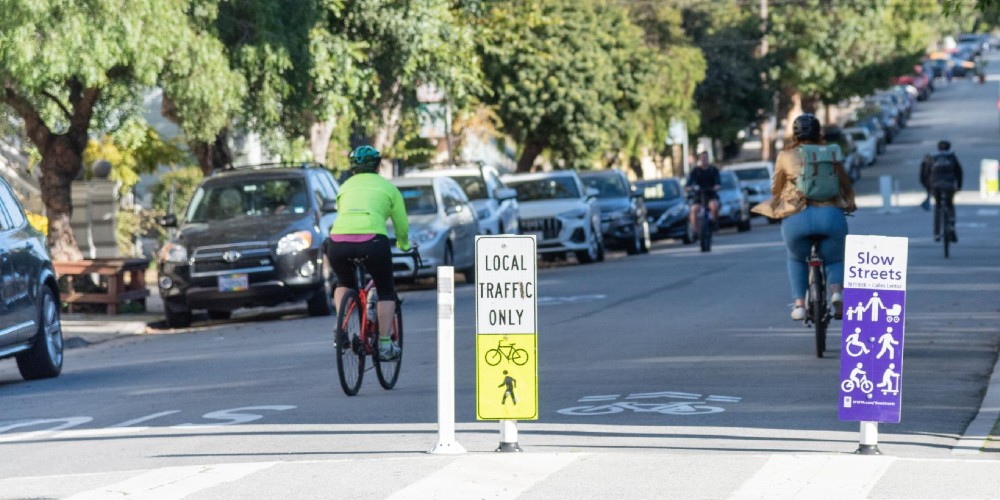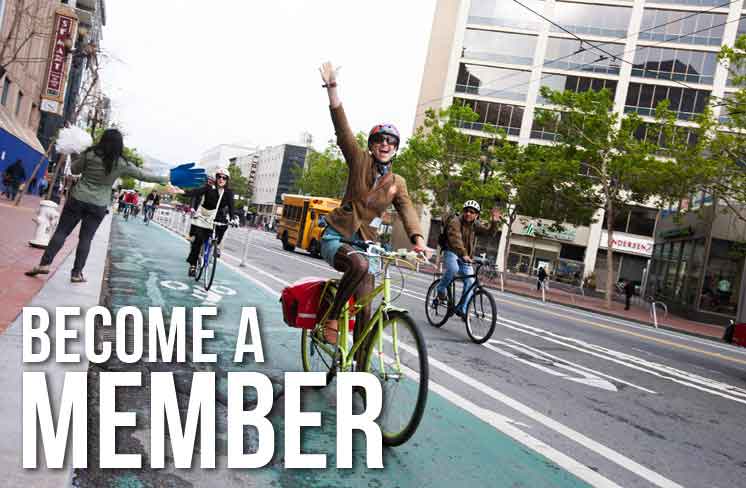photo credit: SFMTA
Update as of 9/28: The vote has been moved up to Dec 6.
Slow Streets across San Francisco provide not just safer routes for people biking, rolling, and walking. They’re places for communities to gather, find joy, and activate our biggest shared civic space — our streets. While these spaces were created as a part of the pandemic, what if we were able to make them permanent fixtures of SF life? On September 20, we have the opportunity to evolve this program from a temporary, emergency solution to an ongoing program — and to make sure it serves all the city’s neighborhoods, especially in underserved communities.
Outside of the few existing permanent corridors, the current Slow Streets program is part of the COVID-19 State of Emergency orders. This program is authorized to continue for 120 days past the lifting of the State of Emergency, which could happen any time at the Mayor’s discretion. If it were lifted and no action were taken, existing Slow Streets would revert to their previous states, often with high speeds and high traffic. Now that we know how fruitful these community and people-first spaces can be, we cannot accept a future where San Francisco no longer has Slow Streets.
Up until now, the only way to seek permanence for a Slow Street required neighbors and the SFMTA to gain approval street-by-street — a grueling and slow-moving effort. Now, the SFMTA is hoping to make this process more efficient by passing an ongoing, more clearly defined program that allows the creation of a citywide network of permanent Slow Streets, as well as establishing the criteria and process for accepting permanent Slow Streets in the future. This new approach, if done right, could impact the whole city and rapidly accelerate the transformation of street space.
So, we are focusing our organizing efforts on shaping the vision for the program, ensuring the process is equitable and involves robust community involvement, and getting it approved. Our timeline to get it right is short — the agency hopes to present the program for approval at the September 20 SFMTA Board meeting.
Here’s what we know so far about what the proposed permanent Slow Street’s program will look like:
The SFMTA’s approach will be to focus on a set of specific outcomes that the program aims to achieve on included streets. In particular, the SFMTA wants to set goals to lower the average speed and the maximum number of vehicle trips taken on Slow Streets. If approved, the program will have the freedom to try out designs to achieve these outcomes, without needing every design to endure another lengthy, contentious approval process. Instead, designs can be tried, assessed, and changed until the outcomes are met.
In the initial proposal, SFMTA staff will propose a set of the current Slow Streets to include in the permanent program. Part of the aim is to create a citywide network of interconnected, people-first streets that are safe and comfortable for all ages. The proposal will also include a process by which new streets can be added to the program, continuing to grow that network throughout the city. It’s imperative that the way these initial streets are chosen are thoughtful and serve neighborhoods in SF that are especially underserved in access to transit and open space.
In the coming weeks we will be pushing the SFMTA to design the best program possible. We want to see a Slow Streets network that creates more, consistently safer spaces for people biking, walking, and recreating — and we demand that the program be equitable in how it serves the city. To do so, we believe that it needs to:
- Be responsive to local community input;
- Serve all neighborhoods in the city, in locally appropriate and welcomed ways;
- Consider not just transportation needs, but needs for open space in neighborhoods that are underserved by it;
- Create a clear, community-friendly pathway for new streets to join the network, including funding for low-income neighborhoods to come together and pilot their own vision for a people-first street.
In the coming weeks, we’ll be having conversations with people and community groups across the city, to continue to better understand what different folks need from the program. While creating a program for a city as diverse and varied as San Francisco will be a challenge, this is a tremendous opportunity for a transformative change towards safer, more equitable, people-first streets.
September 20 will come fast. To get involved, sign up for Slow Streets alerts to ensure you hear all the new details as soon as we have them, and to learn more about how you can weigh in and support permanent Slow Streets.


